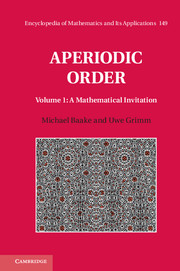Book contents
- Frontmatter
- Contents
- Foreword
- Preface
- Chapter 1 Introduction
- Chapter 2 Preliminaries
- Chapter 3 Lattices and Crystals
- Chapter 4 Symbolic Substitutions and Inflations
- Chapter 5 Patterns and Tilings
- Chapter 6 Inflation Tilings
- Chapter 7 Projection Method and Model Sets
- Chapter 8 Fourier Analysis and Measures
- Chapter 9 Diffraction
- Chapter 10 Beyond Model Sets
- Chapter 11 Random Structures
- Appendix A The Icosahedral Group
- Appendix B The Dynamical Spectrum
- References
- List of Examples
- List of Remarks
- Index
Chapter 9 - Diffraction
Published online by Cambridge University Press: 18 December 2014
- Frontmatter
- Contents
- Foreword
- Preface
- Chapter 1 Introduction
- Chapter 2 Preliminaries
- Chapter 3 Lattices and Crystals
- Chapter 4 Symbolic Substitutions and Inflations
- Chapter 5 Patterns and Tilings
- Chapter 6 Inflation Tilings
- Chapter 7 Projection Method and Model Sets
- Chapter 8 Fourier Analysis and Measures
- Chapter 9 Diffraction
- Chapter 10 Beyond Model Sets
- Chapter 11 Random Structures
- Appendix A The Icosahedral Group
- Appendix B The Dynamical Spectrum
- References
- List of Examples
- List of Remarks
- Index
Summary
Mathematical diffraction theory is concerned with the precise measure-theoretic formulation of kinematic diffraction in the classic Fraunhofer picture [Cow95, Hof95a]. In this setting, the diffraction measure is given by the Fourier transform of the autocorrelation of the initial structure. The corresponding inverse problem deals with the reconstruction of the initial structure from the diffraction measure. The solution is generally not unique, which makes this a hard problem. Here, we introduce the necessary tools for the mathematical theory of kinematic diffraction, followed by the explicit treatment of crystallographic systems and regular model sets. Our approach also permits the explicit construction of homometric model sets.
Mathematical diffraction theory
A diffraction image emerges via the interference of waves that are scattered by an ‘obstacle’, or by a collection of obstacles. Diffraction occurs in many situations of wave propagation, and is fully described by the solutions of the corresponding wave equation. Fortunately, standard situations from optics and crystallography allow a considerable simplification via Fourier analysis in Fraunhofer's far field limit. We omit the underlying derivation, and refer to [HZ74, Ch. 10] and [Höf01] for very readable introductions. The essential connection that we need below is the description of the diffraction image as the absolute square of the Fourier transform of the obstacle. The latter is traditionally modelled by a function, which will be extended to a measure in our setting.
- Type
- Chapter
- Information
- Aperiodic Order , pp. 333 - 396Publisher: Cambridge University PressPrint publication year: 2013

